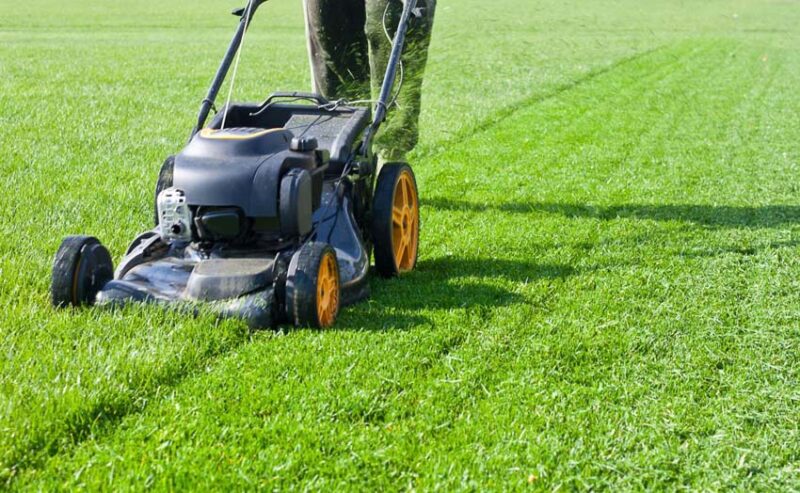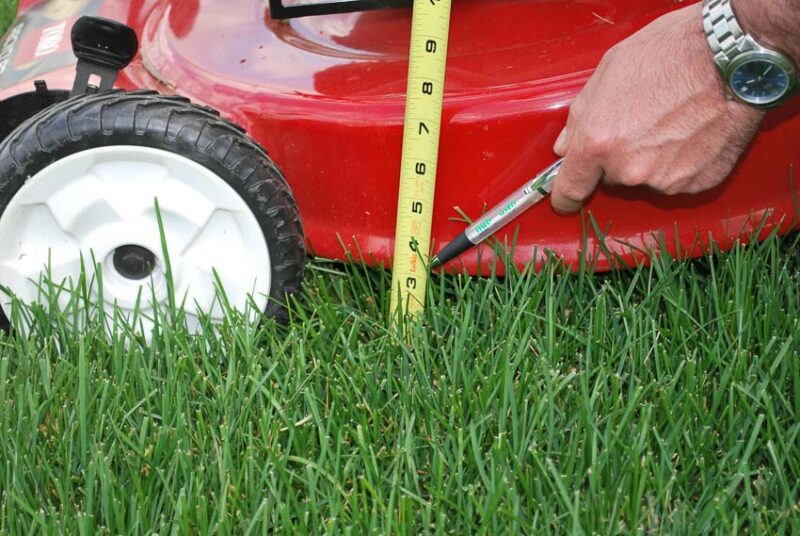How to Identify, Plant, and Care for Perennial Ryegrass
What is Perennial Ryegrass?
Perennial Ryegrass (Lolium Perenne) is a fine-bladed, cool-season grass. Due to its origins in Europe and Asia, it grows well in areas with cool winters and moderate summers. Known for its fast growth, it’s reasonably drought-resistant and can tolerate some shade. A lawn made from this grass is durable and, therefore, multipurpose. Our Perennial Ryegrass guide will help you identify, plant, and care for this popular turf.
Reasons to Choose Perennial Ryegrass

The main qualities that make this grass a good choice include:
- Fast germination
- Creates a dense sod
- Resistant to foot traffic
- Fibrous roots that help bind the soil
- Useful as a winter grass in southern regions
Identifying Perennial Ryegrass

Perennial Ryegrass is similar in appearance to Kentucky bluegrass, featuring pale green, fine-bladed leaves with shiny backs. The base of the stem is green, with a reddish-purple base.
It can grow up to 3.3 feet and will produce flowers with a spike-like seedhead.
Fast-growing and durable, Perennial Ryegrass is ideal for yards, as well as sports fields and golf courses (including Britain’s Wimbledon Tennis Club and the Augusta Masters course in Georgia). Indeed, it’s one of the most common lawn grasses in the United States.
What regions is Perennial Ryegrass suitable for?
In northern regions
Perennial Ryegrass is most suitable for northern lawns. It does well in the humid conditions of the Pacific coast, Midwest states, and in cooler eastern zones. In these areas, this grass will create a hardy lawn.
As its name suggests, fall and spring are the best growing seasons for Perennial Ryegrass. It falls dormant in summer but does not turn brown or die off.
While it’s generally robust, prolonged cold spells below 30F can stunt its growth, or worse, kill it.
In southern regions
When warm region grasses such as Bermuda grass go brown in southern winters, Perennial Ryegrass comes into its own to provide a temporary winter turf. If they seed in the fall, southern lawn owners can enjoy a green yard all year.
Seeding and Germination
This grass is quick to germinate. Therefore, a good fall or spring seeding can create a swiftly-established lawn. Perennial Ryegrass prefers fertile soil but will grow in all soil types except for very wet areas.
As with all plants, proper soil preparation and necessary improvements yield the best results.
Perennial Ryegrass grows best in a soil pH of 5.5-7.5. However, it will tolerate a wider PH range between 4.5 and 8.4.
Get your lawn off to a good start. Try to prepare the seedbed six months before sowing to give seedlings the best chance. Apply a high-nitrogen organic fertilizer to compensate for any soil imbalances.
Choosing the right seed

There are many varieties of Perennial Ryegrass, and selective breeding has created premium blends with enhanced qualities. For example, you can buy Perennial Ryegrass that has a seed coat fortified with fertilizer.
These newer varieties are labor-saving, too. Agronomists have developed seeds that require up to 30% less water than ordinary grasses, as well as less mowing than common strains.
You can also buy seed mixes containing Kentucky bluegrass, which gives your lawn the best features of both types.
Seeding northern lawns

Sow Perennial Ryegrass seeds about a quarter to half an inch deep. Using a lawn spreader can make this easier. Furthermore, you should pack the soil to ensure that it has sufficient contact with the seed.
Next, water it well and keep the soil moist until germination, monitoring its condition with a moisture sensor if necessary.
Seeds germinate in temperatures between 50F and 65F. This takes 5-14 days, by which time the grass will have reached two inches. You can then start your mowing regime.
Seeding southern lawns in the fall
When southern lawns go brown and dormant in winter, sowing Perennial Ryegrass is a popular solution. By creating a winter lawn with cooler-season grasses, homeowners can have a beautiful green yard all year round.
Mid-October to mid-November is the best time to overseed southern lawns. Daytime temperatures need to be 78F to 83F and, at night, 55F or cooler.
You should first mow your existing lawn shorter to give seedlings a chance to access light and nutrients. Do this over several passes, shortening the blade each time. Make sure you remove all the clippings and then use a rake to aerate the earth. This ensures the seeds make good contact with the soil.
Distribute the seed evenly using a spreader, then add a layer of sand about an eighth to a quarter of an inch on top of the seed.
Water the seed into the soil about half an inch deep, and continue with a watering schedule of short bursts several times a day until the seeds germinate.
Mowing Perennial Ryegrass

In northern regions
This variety requires regular mowing to create a dense, lush lawn.
Start your mowing when growth begins in spring. This may vary from region to region, but also year to year. Keep the grass at an optimum length of 1.5 to 2.5 inches.
You can also use clippings to mulch your lawn and add vital nutrients. However, you should discard the first mow of the season, so you don’t spread winter fungal disease.

As the weather gets hotter, keep the grass between 3 and 4 inches to conserve moisture. Mow regularly, removing a third of the blade at a time.
Once the weather begins to cool in fall, reduce the grass height back to its springtime length. Continue to mow until growth stops in winter.
Mowing Perennial Ryegrass in the south
After a couple of weeks, when the grass reaches 2 inches, begin mowing to between 1 and 1.5 inches.
Watering regimes

Established lawns in the north
Both new grass and established lawns require about an inch of water per week. It’s best to give a thorough watering, so the moisture penetrates the roots and encourages deeper growth.
When the weather cools in the fall, reduce irrigation. Aim for an inch of water (including rainfall) every 10-14 days.
Watering in hotter southern regions
In southern climates, continue watering your lawn, giving your Perennial Ryegrass an inch of water per week.
Fertilizing Perennial Ryegrass
Apply a nitrogen-rich organic fertilizer in spring and fall. You can also make use of mulching to return nutrients to the soil.
Avoid leaving clippings on dormant lawns to prevent the spread of mold and fungus.
Weeding Perennial Ryegrass
Clump-forming grass tends to choke out weeds. Nonetheless, keep an eye out for any that appear in barer patches. Pull weeds out manually, then reseed to create a denser area where they can’t thrive.
Diseases Affecting Perennial Ryegrass
Like all cultivated lawns, Perennial Ryegrass is susceptible to diseases, which are often related to the environment or poor lawn management.
Causes of stress in cool-season grasses
- Weather: Warmer weather is more problematic for cool-season grasses. Heavy rain or drought can lower your lawn’s defenses, making it vulnerable to disease.
- Watering: Follow guidelines and avoid over-watering.
- Mowing: Establish a good mowing routine and keep the grass at recommended heights.
- Fertilization: Both over- and under-fertilizing can lead to problems. Try to balance your lawn’s needs.
- PH management: Good soil management requires attention to its relative acidity or alkalinity.
Prevention is better than cure, and while fungal diseases can be treated with fungicides, treatments that solve one problem may cause another.
Dollar Spot

This fungal disease appears in late spring or fall and gets its name from its characteristic white patches, which are usually 1 to 3 inches in diameter. Under-fertilizing is sometimes a root cause.
Rust

Similarly, Perennial Ryegrass is susceptible to rust, especially in shady areas. The culprits are fungus spores that typically emerge in the fall.
Stress due to periods of drought or high humidity can cause rust to take hold. Avoid overwatering and make sure to keep the grass fertilized.
Brown patch

This is a common fungal disease in hot and humid weather and can be related to the over-application of nitrogen. The problem manifests in circular brown patches of dead leaves, ranging from a few inches to several feet in diameter.
Excess watering can worsen its spread.
Pythium blight

Pythium blight is a fungal disease caused by poor air circulation and excess moisture. Typically, this happens in hot, humid weather with night temperatures above 70F.
Initially appearing as small spots a few inches in diameter, diseased leaves become soft and slimy and then shrivel. In areas of heavy dew, cottony fungal growths appear, turning into light brown patches.
Over-fertilizing and over-watering can be to blame. Also, improving soil structure tends to help, as over-compaction can be responsible.



